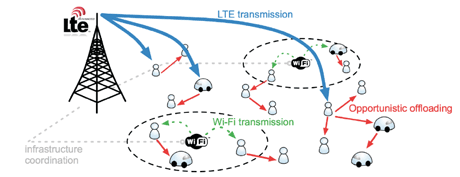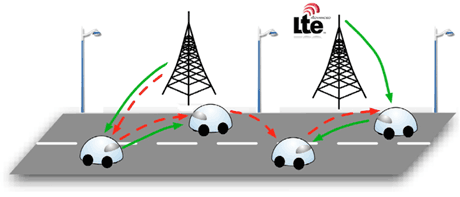by Raffaele Bruno, Andrea Passarella, Leandro D’Orazio and Filippo Visintainer
Map-based Advanced Driver Assistance Systems (ADAS) is one of the key applications for future “Intelligent Car” environments. Unfortunately, network capacity limitations may hinder their efficiency and large-scale adoption. The FP7 MOTO project investigates offloading on vehicle to vehicle (V2V) opportunistic networks as a suitable way to overcome such limitations, thus enabling ADAS and other data-hungry future vehicular applications.
Modern ADAS applications largely take advantage of maps with detailed information to support the users’ driving behaviour (curve speed warning, passing/overtaking assistant, eco-routing/eco-driving). These maps are more accurate than those used for simple navigation and contain very high definition details, such as enhanced geometry, road curvature, height, slope, speed limits, lane information, etc. Since real-time updates are required, car manufacturers support the storage of these maps in central servers, where they are updated periodically, and can be downloaded in real time through mobile communication technologies.
A drawback to this model is that during moderate to high vehicular traffic conditions, the bandwidth available to individual users may be limited, even when modern cellular technologies (ie Long-Term Evolution, LTE) are used. Despite extremely high peak rates, the net throughput available to LTE users is not expected to exceed a few Mbps [1]. In moderate to heavy vehicular traffic conditions, when ADAS network traffic is supported by only a few LTE Base Stations (eNodeBs), the ADAS applications together with other data-hungry applications served by the same eNodeBs are very likely to saturate this capacity.
The FP7 MOTO project is a recently started EU project under the “Future Networks” Objective. MOTO investigates how to exploit mobile opportunistic networking solutions to offload traffic from congested cellular infrastructures, and considers ADAS applications in vehicular environments as one of the key use cases. An opportunistic network [2] is a mobile self-organizing network formed, in this case, by vehicles that communicate directly through wireless technologies (in the case of vehicular applications, the MOTO project focuses on the IEEE 802.11p standard in ad hoc mode). Unlike the conventional Mobile Ad hoc Networking (MANET) paradigm, in opportunistic networks the existence of a simultaneous end-to-end multi-hop path between senders and receivers is not taken for granted. Instead, messages are routed dynamically towards the final destination(s), by exploiting communication opportunities that arise thanks to the nodes’ mobility (eg, two vehicles coming close enough to establish a direct single hop wireless connection). Whenever such an event occurs, each node immediately evaluates the suitability of the other to carry locally stored messages closer and closer to the final destination and, if appropriate, hands over messages. This approach avoids problems typical of mobile ad hoc networks, such as disconnections, network partitions, and topology instability.

The opportunistic networking paradigm has recently been gaining momentum as a solution for offloading traffic from congested cellular networks in the case of heavy data traffic concentrated in well-identified physical areas [3]. The main idea behind MOTO (see Figure 1) is that offloading can be most beneficial when a large number of users located in a given physical area need to download (almost) the same information at (almost) the same time from central servers. This is exactly the scenario of ADAS applications, as drivers moving in a congested area need the same maps containing the same information at almost the same time (although multicasting is typically not viable, due to the dynamicity of the vehicular traffic and the absence of synchronization among vehicles). Applying offloading to support ADAS applications is, thus, one of the use cases and scenarios considered by MOTO (see Figure 2). Relying exclusively on LTE, vehicles would need to establish a dedicated connection to the central servers, from which to download the multimedia files required by the ADAS application. The physical co-location of vehicles means that this network traffic will have to be sustained by a very limited number of eNodeBs, and consequently the congestion resulting from ADAS traffic (and possibly other “background” multimedia traffic generated by the users) over the LTE network may be excessive. To avoid this problem and allow ADAS applications to be effective, MOTO solutions select a subset of vehicles (seeds) which can download the maps from the central servers through the LTE network. The maps are then disseminated through V2V communications using 802.11p technology to the other interested users, exploiting mobile opportunistic data dissemination protocols. As a last-resort option, individual users may resort to the LTE network when the maps have not been received by a stated deadline. By exploiting MOTO services, drivers should receive the detailed maps required by the ADAS application, while drastically reducing the congestion on the LTE network (thus avoiding blocking and lock-out problems). At the current stage (first six months in the project), we have defined in detail the use cases for offloading through opportunistic networking in vehicular scenarios. The system-level architecture required to support offloading from LTE to opportunistic networks is about to be released. Moreover, we are running extensive simulations to quantify the limit of LTE-only solutions in supporting ADAS applications, and the benefit coming from a solution based on offloading.

While ADAS applications are one of the specific focuses of the MOTO project, the same offloading techniques may directly or indirectly help a range of other applications and services that future intelligent cars are likely to offer. For example, opportunistic networks formed by vehicles can natively support data dissemination between vehicles, for traffic alert applications, or infotainment applications, without overloading the LTE network. Offloading should also indirectly help safety-critical applications as the LTE network will not be congested due to the traffic of non-safety-critical applications, and could more easily sustain time-sensitive traffic. At the same time, non-safety-critical applications will not be blocked, but can still be supported through the opportunistic part of the network.
The MOTO project is coordinated by Thales (France) and also involves CNR (Italy), CRF (Italy), UPMC (France), AVEA (Turkey), FON (UK) and Intecs (Italy).
Link:
http://www.fp7-moto.eu
References:
[1] L. Korowajczuk (Editor): “LTE, WiMAX and WLAN Network Design, Optimization and Performance Analysis”, Wiley, July 2011.
[2] L. Pelusi, A. Passarella, M. Conti: “Opportunistic Networking: data forwarding in disconnected mobile ad hoc networks”, IEEE Communications Magazine, vol. 44, no. 11, November 2006, pp. 134-141
[3] J. Whitbeck et al: “Push-and-Track: Saving Infrastructure Bandwidth Through Opportunistic Forwarding”, Elsevier Pervasive and Mobile Computing, vol. 8, issue 5 (August 2012), pages 682-697
Please contact:
Raffaele Bruno, Andrea Passarella, IIT-CNR, Italy
E-mail:
Leandro D’Orazio
Centro Ricerche Fiat, Italy
E-mail:
Filippo Visintainer
Centro Ricerche Fiat, Italy
E-mail:











